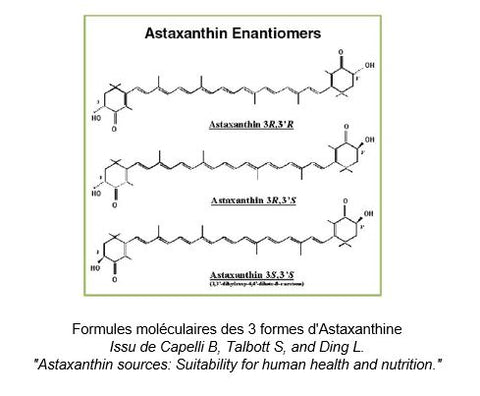
Découvertes scientifiquesNos actifs 27/07/2020
The 3 sources of astaxanthin: which one to choose?
Astaxanthin is a molecule from the carotenoid family. Skin protection, eye health, athletic performance, heart health, and fertility are all virtues widely studied in the scientific literature. Its origin, however, is not always very clear: is it astaxanthin from natural sources? Synthetic astaxanthin? Or astaxanthin produced from yeast?
Questions surrounding the sources of astaxanthin are numerous. And even more important when it comes to choosing your dietary supplement. A look back at the recent research by Capelli, Tallbott, and Ding to take stock.
Choosing your astaxanthin with science
Published in 2019 in the scientific journal Functional Foods in Health and Disease, the research by Capelli B., Talbott S. and Ding L. is a literature compilation on astaxanthin [1]. It covers the 3 sources of astaxanthin, their chemical and antioxidant differences, and their health benefits. This scientific research helps to better understand the origins of this antioxidant and to choose its source wisely.
Astaxanthin and its 3 sources
This research identified 3 forms of astaxanthin that come from different sources.
- Natural astaxanthin is generally extracted from the green alga Haematococcus pluvialis. Haematococcus pluvialis is a unicellular microalga that grows in freshwater and contains the highest amounts of astaxanthin.
- Synthetic astaxanthin is produced from petrochemical products.
- Phaffia astaxanthin is extracted from the yeast Xanthophyllomyces dendrorhous (Phaffia rhodozyma). This yeast, which naturally produces very small amounts of astaxanthin, has been genetically modified to produce it exponentially.
Study results: which one to choose and why?
The three forms of astaxanthin show differences in chemical composition, antioxidant activity, and health benefits.
Chemical differences
Natural, synthetic, and Phaffia astaxanthin differ in their molecular formula and composition.
Their molecular formulas have different forms (figure below). These forms are known as enantiomers: the "S" enantiomer (3S,3'S), the "R" enantiomer (3R,3'R), and the "meso" enantiomer (3R,3'S). Natural astaxanthin contains only the "S" enantiomer (3S,3'S). Synthetic astaxanthin contains a variety of the three enantiomers. Phaffia astaxanthin contains exclusively the "R" enantiomer (3R,3'R).
Regarding differences in their composition, two aspects should be noted. First, natural astaxanthin is composed of 95.7% esterified molecules, which is not the case for synthetic astaxanthin and Phaffia, which are "free", i.e., non-esterified. Second, synthetic and Phaffia astaxanthin do not contain other carotenoids besides astaxanthin. Conversely, natural astaxanthin is composed of other carotenoids, namely cantaxanthin, beta-carotene, zeaxanthin, and lutein.
Differences in antioxidant activity
In addition to chemical differences, the authors also discovered differences in the strength of antioxidant activity of the astaxanthin forms. Based on two in vitro studies, they were able to establish a superior antioxidant activity of natural astaxanthin compared to synthetic.
The first study, published in 2013, found that astaxanthin in its natural form was at least 14 times more potent than synthetic astaxanthin in terms of antioxidant activity [2]. Furthermore, this study tested the effect of astaxanthins on 5 free radicals present in the human body. The results highlighted that natural astaxanthin was more active in eliminating singlet oxygen (up to 55x more active), superoxide ion, and peroxyl radicals, while synthetic astaxanthin was more active against peroxynitrite [2].
The second study, published in 2015, also highlighted the superior antioxidant capacity of natural astaxanthin [3]. In this study, the researchers tested and compared two natural astaxanthins to a synthetic one. The two natural forms had antioxidant activity about 90 times stronger than that of synthetic astaxanthin [3].
Regarding the comparison with Phaffia astaxanthin, the researchers were not aware of any study comparing Phaffia astaxanthin to other forms. However, since Phaffia astaxanthin is chemically similar to synthetic astaxanthin, they postulate that natural astaxanthin would also have superior antioxidant activity.
Safety and consumption security
Another important aspect is pointed out by the research of Capelli, Talbott, and Ding: safety. Here again, the three forms of astaxanthin show differences.
Natural astaxanthin has been the subject of several clinical trials that have demonstrated its safety and a wide variety of health benefits. Moreover, for more than 20 years, it has been consumed as a dietary supplement without reported adverse effects.
On the other hand, synthetic astaxanthin and Phaffia astaxanthin have not been proven safe for human consumption in clinical trials. This is also why they have not been authorized by government regulatory agencies in many countries.
Conclusion: which source of astaxanthin to choose?
According to this study, natural astaxanthin seems to be the best choice for your dietary supplements.
Indeed, the research conducted by Capelli, Talbott, and Ding highlighted a superior antioxidant activity and safety of natural astaxanthin. Until the efficacy and safety of synthetic astaxanthin and Phaffia have been demonstrated, the authors recommend choosing natural astaxanthin as a source of dietary supplement.


